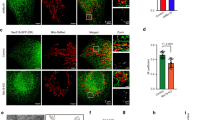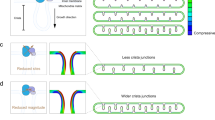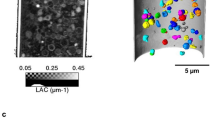Abstract
Seven subunits of the mitochondrial contact site and cristae junction (CJ) organizing system (MICOS) in humans have been recently described in function and structure. QIL1 (also named MIC13) is a small complex that is crucial for the maintenance and assembling of MICOS. A novel mutation of an essential splice site in the C19orf70 gene encoding QIL1 induces severe mitochondrial encephalopathy, hepatopathy and lactate acidosis consistent with psychomotor retardation. In addition, bilateral kidney stones were observed. Disassembly of MICOS complex subunits displays lack of MIC10-MIC26-MIC27-QIL1 subcomplex, resulting in aberrant cristae structure and a loss of cristae junctions and contact sites. In liver and muscle tissue, the activity of the respiratory chain complexes (OXPHOS) was severely impaired. Defects in MICOS complex do not only affect mitochondrial architecture, but also mitochondrial fusion, metabolic signalling, lipid trafficking and cellular electric homeostasis.
Similar content being viewed by others
Log in or create a free account to read this content
Gain free access to this article, as well as selected content from this journal and more on nature.com
or
References
Karbowski M, Neutzner A. Neurodegeneration as a consequence of failed mitochondrial maintenance. Acta Neuropathol. 2012;123:157–71.
Nunnari J, Suomalainen A. Mitochondria: in sickness and in health. Cell. 2012;148:1145–59.
Holt IJ, Harding AE, Cooper JM, Schapira AH, Toscano A, Clark JB, et al. Mitochondrial myopathies: clinical and biochemical features of 30 patients with major deletions of muscle mitochondrial DNA. Ann Neurol. 1989;26:699–708.
Rodenburg RJT. Biochemical diagnosis of mitochondrial disorders. J Inherit Metab Dis. 2011;34:283–92.
Mannella CA. The relevance of mitochondrial membrane topology to mitochondrial function. Biochim Biophys Acta. 2006;1762:140–7.
Rampelt H, Zerbes RM, van der Laan M, Pfanner N. Role of the mitochondrial contact site and cristae organizing system in membrane architecture and dynamics. Biochim Biophys Acta. 2017;1864:737–46.
Zick M, Rabl R, Reichert AS. Cristae formation-linking ultrastructure and function of mitochondria. Biochim Biophys Acta. 2009;1793:5–19.
Pernas L, Scorrano L. Mito-morphosis: mitochondrial fusion, fission, and cristae remodeling as key mediators of cellular function. Annu Rev Physiol. 2016;78:505–31.
Barbot M, Jans DC, Schulz C, Denkert N, Kroppen B, Hoppert M, et al. Mic10 oligomerizes to bend mitochondrial inner membranes at cristae junctions. Cell Metab. 2015;21:756–63.
Harner M, Körner C, Walther D, Mokranjac D, Kaesmacher J, Welsch U, et al. The mitochondrial contact site complex, a determinant of mitochondrial architecture. EMBO J. 2011;30:4356–70.
van der Laan M, Horvath SE, Pfanner N. Mitochondrial contact site and cristae organizing system. Curr Opin Cell Biol. 2016;41:33–42.
Harner ME, Unger A-K, Geerts WJ, Mari M, Izawa T, Stenger M, et al. An evidence based hypothesis on the existence of two pathways of mitochondrial crista formation. eLife. 2016;5:e18853.
Guarani V, Jardel C, Chrétien D, Lombès A, Bénit P, Labasse C, et al. QIL1 mutation causes MICOS disassembly and early onset fatal mitochondrial encephalopathy with liver disease. eLife. 2016;5:e17163.
Kozjak-Pavlovic V. The MICOS complex of human mitochondria. Cell Tissue Res. 2017;367:83–93.
Pfanner N, van der Laan M, Amati P, Capaldi RA, Caudy AA, Chacinska A, et al. Uniform nomenclature for the mitochondrial contact site and cristae organizing system. J Cell Biol. 2014;204:1083–6.
Guarani V, McNeill EM, Paulo JA, Huttlin EL, Fröhlich F, Gygi SP, et al. QIL1 is a novel mitochondrial protein required for MICOS complex stability and cristae morphology. eLife 2015;4:e06265.
Hessenberger M, Zerbes RM, Rampelt H, Kunz S, Xavier AH, Purfürst B, et al. Regulated membrane remodeling by Mic60 controls formation of mitochondrial crista junctions. Nat Commun. 2017;8:15258.
Körner C, Barrera M, Dukanovic J, Eydt K, Harner M, Rabl R, et al. The C-terminal domain of Fcj1 is required for formation of crista junctions and interacts with the TOB/SAM complex in mitochondria. Mol Biol Cell. 2012;23:2143–55.
Schorr S, van der Laan M. Integrative functions of the mitochondrial contact site and cristae organizing system. Semin Cell Dev Biol. 2017, https://doi.org/10.1007/8904_2017_48.
Wollweber F, von der Malsburg K, van der Laan M. Mitochondrial contact site and cristae organizing system: a central player in membrane shaping and crosstalk. Biochim Biophys Acta. 2017;1864:1481–9.
Bohnert M, Zerbes RM, Davies KM, Mühleip AW, Rampelt H, Horvath SE, et al. Central role of Mic10 in the mitochondrial contact site and cristae organizing system. Cell Metab. 2015;21:747–55.
Friedman JR, Mourier A, Yamada J, McCaffery JM, Nunnari J. MICOS coordinates with respiratory complexes and lipids to establish mitochondrial inner membrane architecture. eLife 2015;4:e07739.
Anand R, Strecker V, Urbach J, Wittig I, Reichert AS. Mic13 is essential for formation of crista junctions in mammalian cells. PLoS ONE. 2016;11:e0160258.
Eydt K, Davis KM, Behrendt C, Wittig I, Reichert AS. Cristae architecture is determined by an interplay of the MICOS complex and the F1Fo ATP synthase via Mic27 and Mic10. Microb Cell. 2017;4:259–72.
Zerbes RM, Höß P, Pfanner N, van der Laan M, Bohnert M. Distinct roles of Mic12 and Mic27 in the mitochondrial contact site and cristae organizing system. J Mol Biol. 2016;428:1485–92.
Mannella CA, Pfeiffer DR, Bradshaw PC, Moraru II, Slepchenko B, Loew LM, et al. Topology of the mitochondrial inner membrane: dynamics and bioenergetic implications. IUBMB Life. 2001;52:93–100.
Zeharia A, Friedman JR, Tobar A, Saada A, Konen O, Fellig Y, et al. Mitochondrial hepato-encephalopathy due to deficiency of QIL1/MIC13 (C19orf70), a MICOS complex subunit. Eur J Hum Genet. 2016;24:1778–82.
Zühlsdorf A, Park JH, Wada Y, Rust S, Reunert J, DuChesne I, et al. Transferrin variants: pitfalls in the diagnostics of congenital disorders of glycosylation. Clin Biochem. 2015;48:11–3.
Biskup S. Hochdurchsatz-Sequenzierung in der Humangenetischen Diagnostik. Next-generation sequencing in genetic diagnostics. J. Lab. Med. 2010;34:305–309.
Braun DA, Lawson JA, Gee HY, Halbritter J, Shril S, Tan W, et al. Prevalence of monogenic causes in pediatric patients with nephrolithiasis or nephrocalcinosis. Clin J Am Soc Nephrol. 2016;11:664–72.
Reynolds ES. The use of lead citrate at high pH as an electron-opaque stain in electron microscopy. Cell Biol. 1963;17:208–21.
Janssen AJM, Trijbels FJM, Sengers RCA, Smeitink JAM, Heuvel LP, van den, Wintjes LTM, et al. Spectrophotometric assay for complex I of the respiratory chain in tissue samples and cultured fibroblasts. Clin Chem. 2007;53:729–34.
Mourmans J, Wendel U, Bentlage HACM, Trijbels JMF, Smeitink JAM, de Coo IFM. et al. Clinical heterogeneity in respiratory chain complex III deficiency in childhood. J Neurol Sci. 1997;149:111–7.
Cooperstein SJ, Lazarow A. A microspectrophotometric method for the determination of cytochrome oxidase. J Biol Chem. 1951;189:665–70.
Lightowlers RN, Taylor RW, Turnbull DM. Mutations causing mitochondrial disease: what is new and what challenges remain? Science. 2015;349:1494–9.
Powell CA, Kopajtich R, D’Souza AR, Rorbach J, Kremer LS, Husain RA, et al. TRMT5 mutations cause a defect in post-transcriptional modification of mitochondrial tRNA associated with multiple respiratory-chain deficiencies. Am J Hum Genet. 2015;97:319–28.
Garone C, D’Souza AR, Dallabona C, Lodi T, Rebelo-Guiomar P, Rorbach J, et al. Defective mitochondrial rRNA methyltransferase MRM2 causes MELAS-like clinical syndrome. Hum Mol Genet. 2017;26:4257–66.
Cogliati S, Frezza C, Soriano ME, Varanita T, Quintana-Cabrera R, Corrado M, et al. Mitochondrial cristae shape determines respiratory chain supercomplexes assembly and respiratory efficiency. Cell. 2013;155:160–71.
Rieger B, Junge W, Busch KB. Lateral pH gradient between OXPHOS complex IV and F(0)F(1) ATP-synthase in folded mitochondrial membranes. Nat Commun. 2014;5:3103.
Finsterer J, Scorza F. Renal manifestations of primary mitochondrial disorders. Biomed Rep. 2017;6:487–94.
Garcia-Cazorla À, Mochel F, Lamari F, Saudubray J-M. The clinical spectrum of inherited diseases involved in the synthesis and remodeling of complex lipids. A tentative overview. J Inherit Metab Dis. 2015;38:19–40.
Lu Y-W, Claypool SM. Disorders of phospholipid metabolism: an emerging class of mitochondrial disease due to defects in nuclear genes. Front Genet. 2015;6:3.
Wortmann SB, Duran M, Anikster Y, Barth PG, Sperl W, Zschocke J, et al. Inborn errors of metabolism with 3-methylglutaconic aciduria as discriminative feature: proper classification and nomenclature. J Inherit Metab Dis. 2013;36:923–8.
Huffnagel IC, Redeker EJW, Reneman L, Vaz FM, Ferdinandusse S, Poll-The BT. Mitochondrial Encephalopathy and Transient 3-Methylglutaconic Aciduria in ECHS1 Deficiency: Long-Term Follow-Up. In: JIMD Reports. Springer, Berlin, Heidelberg, 2017, https://doi.org/10.1007/8904_2017_48.
Ferri L, Dionisi-Vici C, Taurisano R, Vaz FM, Guerrini R, Morrone A. When silence is noise: infantile-onset Barth syndrome caused by a synonymous substitution affecting TAZ gene transcription. Clin Genet. 2016;90:461–5.
Acknowledgements
We are grateful to the Evangelisches Krankenhaus Bielefeld for providing the MRI scan and sonographic images of the patient. We would like to thank the technicians of the muscle lab and cell culture lab of the Translational Metabolic Laboratory of the RadboudUMC for excellent technical assistance.
Funding
We acknowledge the support by Open Access Publication Fund of University of Muenster.
Author information
Authors and Affiliations
Corresponding author
Ethics declarations
Consent for publication
Consent for publication was obtained from the patient’s parents.
Ethics approval
Approval for investigations was obtained from the local Bioethics Committee.
Conflict of interest
The authors declare that they have no conflict of interest.
Electronic supplementary material
Rights and permissions
About this article
Cite this article
Gödiker, J., Grüneberg, M., DuChesne, I. et al. QIL1-dependent assembly of MICOS complex–lethal mutation in C19ORF70 resulting in liver disease and severe neurological retardation. J Hum Genet 63, 707–716 (2018). https://doi.org/10.1038/s10038-018-0442-y
Received:
Revised:
Accepted:
Published:
Issue date:
DOI: https://doi.org/10.1038/s10038-018-0442-y
This article is cited by
-
Apolipoprotein O modulates cholesterol metabolism via NRF2/CYB5R3 independent of LDL receptor
Cell Death & Disease (2024)
-
Mic19 depletion impairs endoplasmic reticulum-mitochondrial contacts and mitochondrial lipid metabolism and triggers liver disease
Nature Communications (2024)



